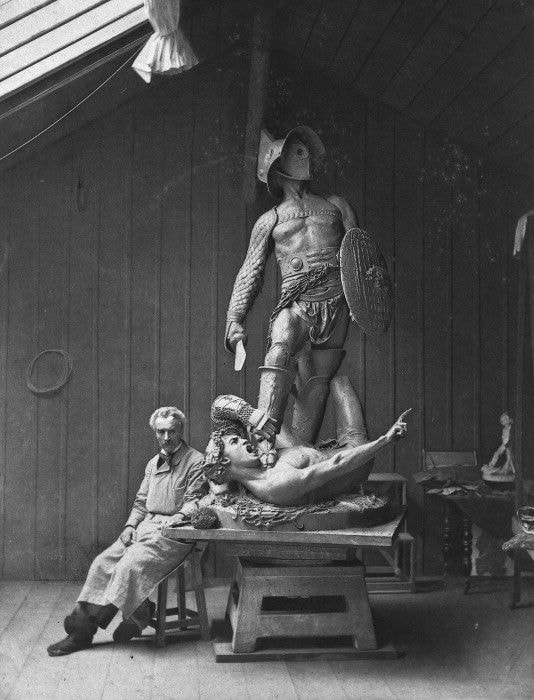
Jean-Léon GEROME
Gérôme was a French painter and sculptor who produced many works in a historical, Orientalist style. Born at Vesoul (Haute-Saône), Gérôme went to Paris in 1841 where he studied at the Académie Julian and worked under Paul Delaroche, whom he accompanied to Italy (1844-1845). On his return he exhibited The Cock-fight, which gained him a third-class medal in the Salon of 1847. Gérôme The Virgin with Christ and Gérôme St John and Anacreon, Gérôme Bacchus and Cupid took a second-class medal in 1848. Gérôme exhibited Bacchus and Love, Drunk, a Greek Interior and Souvenir d'Italie, in 1851; Gérôme Paestum (1852); and Gérôme An Idyll (1853). In 1854 Gérôme made a journey to Turkey and the shores of the Danube, and in 1857 visited Egypt. To the exhibition of 1855 Gérôme contributed a Pifferaro, a Shepherd, A Russian Concert and a large historical canvas, The Age of Augustus and the Birth of Christ. The last was somewhat confused in effect, but in recognition of its consummate ability the State purchased it. Gérôme's reputation was greatly enhanced at the Salon of 1857 by a collection of works of a more popular kind: the Gérôme Duel: after a Masquerade, Gérôme Egyptian Recruits crossing the Desert, Gérôme Memnon and Sesostris and Camels Watering, the drawing of which was criticized by Edmond About. The Cock Fight by Jean-Léon Gérôme, 1847, now in the Musée d'Orsay, Paris In Caesar (1859) Gérôme tried to return to a severer class of work, but the picture failed to interest the public. Phryne before the Areopagus, Le Roi Candaule and Socrates finding Alcibiades in the House of Aspasia (1861) gave rise to some scandal by reason of the subjects selected by the painter, and brought down on him the bitter attacks of Paul de Saint-Victor and Maxime Du Camp. At the same Salon Gérôme exhibited the Egyptian chopping Straw, and Rembrandt biting an Etching, two very minutely finished works.
Gérôme's best paintings are of Eastern subjects; among these may be named the Turkish Prisoner and Turkish Butcher (1863); Prayer (1865); The Slave Market (1867); and The Harem out Driving (1869). He often illustrated history, as in Louis XIV and Molière (1863); The Reception of the Siamese Ambassadors at Fontainebleau (1865); and the Death of Marshal Ney (1868). Gérôme was also successful as a sculptor; he executed, among other works; Omphale (1887), and the statue of the duc d'Aumale which stands in front of the château of Chantilly (1899). His Bellona (1892), in ivory, metal, and precious stones, which was also exhibited in the Royal Academy of London, attracted great attention.
The artist then began an interesting series of Conquerors, wrought in gold, silver and gems Bonaparte entering Cairo (1897); Tamerlane (1898); and Frederick the Great (1899). Gérôme was elected member of the Institut in 1865. His students included: Dagnan-Bouveret, Lecomte du Nouy, Thomas Eakins, Frank Boggs, Frederick Arthur Bridgman, Kenyon Cox, Dennis Miller Bunker, William DeLeftwich Dodge, Wyatt Eaton, Alexander Harrison, Robert Lee MacCameron, Siddons Mowbray, Lawton Parker, Harper Pennington, William Picknell, Julius Stewart, Abbott Handerson Thayer, Vasili Vasilyevich Vereshchagin, Douglas Volk and J. Alden Weir. Jean-Léon Gérôme died in 1904 and was buried in the Montmartre Cemetery.

